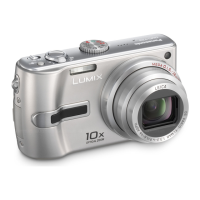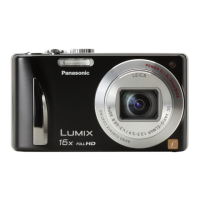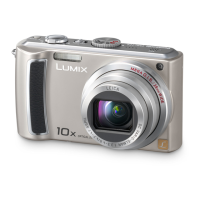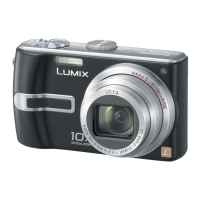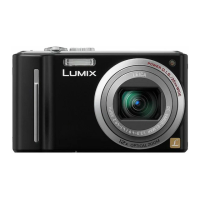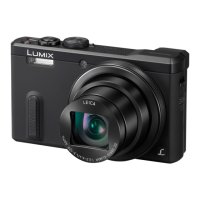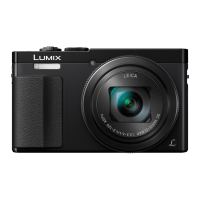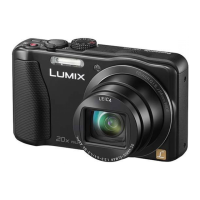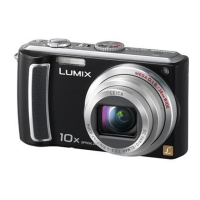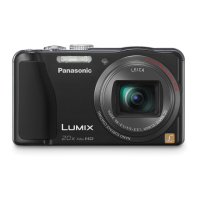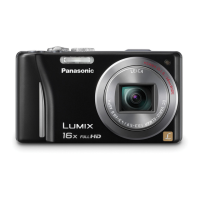
Do you have a question about the Panasonic Lumix DMC-TZ20 and is the answer not in the manual?
| Brand | Panasonic |
|---|---|
| Model | Lumix DMC-TZ20 |
| Category | Digital Camera |
| Language | English |
Recommends test shots before important events to ensure proper camera function.
Provides details on location and landmark data current as of December 2010.
Instructions for safely removing the battery from the camera.
Instructions for safely removing the memory card from the camera.
Explains touch screen interaction for focusing, shooting, and navigation.
Explains how to use the Program AE mode for recording with custom settings.
Guides on aligning the AF area with the subject for initial focus.
Describes the mode that automatically optimizes settings based on scene information.
Explains how the camera automatically identifies scenes for optimal settings.
Enables continuous focus and exposure adjustment on moving subjects.
Explains motion picture recording using Program AE mode with preferred settings.
Describes motion picture recording using Auto mode with scene detection.
Procedure for deleting a single displayed picture.
Guides on selecting multiple or all pictures for deletion.
Illustrates the general procedure for navigating and operating camera menus.
Lists the available menu types such as Rec, Motion Picture, GPS, Setup, and Playback.
Allows setting the camera's time, date, and display format.
Resets all camera settings to their default values.
Initializes the built-in memory or memory card, deleting all data.
Explains different zoom types like Optical, Extra Optical, i.Zoom, and Digital Zoom.
Shows which flash modes are available in different recording modes.
Enables taking pictures at very close distances for macro photography.
Records three pictures in succession with automatic exposure changes.
Control depth of field by setting aperture; shutter speed adjusts automatically.
Allows manual setting of aperture and shutter speed for desired exposure.
Control shutter speed; aperture adjusts automatically for proper exposure.
Allows registering preferred modes and settings for quick switching.
Stores up to 3 custom camera settings for fast recall.
Provides optimized settings for various scenes like portraits, landscapes, and sports.
Explains how to access and select burst shooting settings from the Rec menu.
Details how the camera recognizes faces for focus and exposure adjustments.
Explains face recognition behavior while recording still pictures.
Provides advice for capturing clear face images for accurate recognition.
Guides to access the Face Recognition settings within the Rec menu.
Details on capturing the face image and confirming the registration.
Explains the Global Positioning System and how the camera uses it.
Provides tips for achieving good GPS signal reception and accurate positioning.
Guides on enabling and using the GPS function for location recording.
Instructions for manually repositioning the camera to update location data.
Enables registering personal locations as landmarks for display or recording.
Details the GPS data (latitude, longitude, location name) recorded with images.
Explains how GPS data can automatically update the camera's clock and time zone.
Allows editing or selecting alternative location names or landmarks.
Sets the recording date and time according to the local time at your destination.
Sets the pixel count for still pictures, affecting file size and quality.
Guides on manually setting white balance using a white reference object.
Sets minimum shutter speed for brighter dark-location pictures; recommends tripod.
Automatically detects and corrects red-eye in still pictures, especially with flash.
Allows manual adjustment of ISO sensitivity for low-light photography.
Uses super resolution technology for sharper pictures and improved zoom ratios.
Automatically detects and prevents jitter, especially during motion recording.
Adjusts image coloring to match light sources for natural-looking pictures.
Changes focus alignment method based on subject position and number.
Explains Face Detection feature for recognizing and focusing on faces.
Enables recording a burst of still pictures while the shutter button is pressed.
Enables continuous focus tracking on moving subjects.
Automatically adjusts focus when camera blurring is small, even without pressing shutter.
Enables automatic face recognition for focus and exposure adjustments.
Allows changing the brightness measurement position for exposure correction.
Adjusts contrast and exposure for lifelike colors in high-contrast scenes.
Sets the data format for motion pictures, such as AVCHD or Motion JPEG.
Details the effects and suitability of AVCHD and Motion JPEG formats.
Sets the picture quality for motion pictures, including resolution and bit rate.
Provides image stabilization for jitter reduction when recording motion pictures while walking.
Allows continuous focus adjustment or fixing focus at the start of recording.
Explains how to capture still pictures while recording a motion picture.
Guides on saving a scene from a motion picture as a still image.
Explains how to split a motion picture into two parts for easier management.
Automatically plays pictures in order with music, recommended for TV viewing.
Refines picture selection by categories or favorites for viewing.
Selects pictures for uploading to image-sharing websites like Facebook or YouTube.
Allows adding titles or text to favorite still pictures.
Stamps recording date/time, location, and registered text onto still pictures.
Reduces picture size for easier email attachment and web use.
Allows playback and deletion of only favorite pictures marked with a star.
Sets protection to prevent accidental deletion of important pictures.
Explains the function of the protect feature for safeguarding pictures.
Enables editing location or landmark names recorded by the GPS function.
Enlarges pictures and allows cropping of unwanted areas.
Sets print options like date printing and number of copies for DPOF compatibility.
Allows editing or deleting recognition information for misidentified faces.
Enables copying pictures between the camera's built-in memory and memory card.
Explains the functionality for transferring pictures between storage media.
Guides for connecting the camera via HDMI mini cable for high-resolution viewing.
Instructions for connecting the camera using an HDMI mini cable.
Explains VIERA Link function for integrated operation with compatible devices via HDMI.
Defines VIERA Link and its compatibility with HDMI CEC standards.
Guides on connecting the camera to a 3D TV for playback.
Guides on connecting the camera to a VIERA TV using an HDMI mini cable.
Explains how to view 3D still pictures on a 3D-capable TV.
Instructions for using PHOTOfunSTUDIO software to manage recorded pictures.
Details on using the software to transfer pictures from camera to computer.
Guides on copying still and motion pictures to a computer.
Guides on using the uploading tool to share pictures online.
Provides instructions for connecting to a PictBridge-compatible printer for direct printing.
Details how to configure print settings like date printing and paper size.
Troubleshooting common issues related to camera power and battery.
Troubleshooting issues with GPS positioning, signal reception, and location data.
Addresses problems like inability to record, incorrect exposure, focus, or blur.
Troubleshoots issues with picture brightness, coloring, and motion recording interruptions.
Troubleshoots issues with blackening of red areas, camera sounds during recording, and playback compatibility.
Addresses problems with LCD dimming, brightness instability, flickering, and touch response.
Addresses problems with TV connectivity, computer recognition, and printer issues.
Troubleshoots issues related to flash not emitting or emitting multiple flashes.
Covers troubleshooting for VIERA Link, computer connection, and printing problems.
Addresses issues with rotated pictures, unviewable files, incorrect dates, and playback artifacts.
Provides precautions for using the camera, including avoiding electromagnetic interference.
Cautions regarding handling, storage, and disposal of memory cards to prevent damage.
Highlights that camera data may contain personal information and advises on data protection.
Provides guidelines on battery charging, usage, and lifespan considerations.
